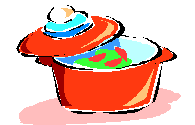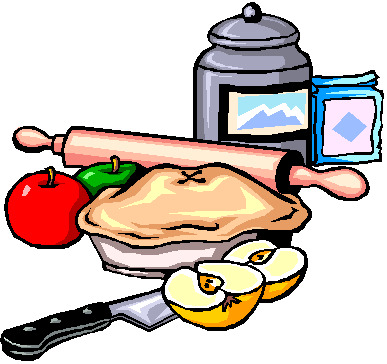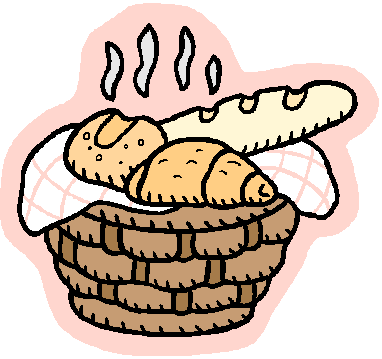
Small Screen, 7(2), 2-5, 1994.
|
Why Not Bring Food and Drink into the Classroom? Johanna E. Katchen |
Cooking shows are perhaps the best known example of a how-to program genre. Although they are generally shown in the daytime and are aimed at housewives, women are not the only ones who watch them; more and more men are learning to cook.
When we use cooking shows in class, our aim is not to turn our students into gourmet cooks, but to have them practice language skills with material that presents new and potentially information. Indeed, cooking shows are not produced to be a substitute for cooking school; they are primarily entertainment that is the same time educational.
Sometimes we come across other how-to programs detailing plumbing repair, shelf construction, makeup application, flower arrangement. These generally have features similar to cooking shows in terms of structure and language and could be used, with a little modification, with the activities suggested here.
If you can't boil an egg, you probably won't want to use a
cooking shows in your class; it is not a genre everybody would feel comfortable
with. However, how-to shows have some unique features that make them
useful pedagogically.
Structure
Cooking shows have a very predictable structure; their actual running time is about 25 minutes. Each episode is usually part of a series on a particular type of cuisine, yet the episode itself has a theme, either regional or on a particular ethnic food, ingredient, or type of food. Others, such as the BBC's long-running Food and Drink, have certain regular features each week, for example, their segment on wine.
Each episode of a cooking show usually has a clear introduction. Then three or four dishes are made, perhaps with the preparation of one more complex dish shown in detail. Time is condensed by showing first the preparation of the dish, then eliminating the cooking time by showing us the same dish already cooked. Transitions between dishes are either done verbally (The next dish ...) or set apart by scenes outside the presenter's kitchen.
There is always a conclusion, either in the form of a summary of what was prepared that day or a cultural scene where the dishes are consumed.
This structure is used over and over again, making the genre easy to follow for both teacher and student. Furthermore, because the parts are easily segmented with each part complete in itself, cooking shows are useful pedagogically. Video in ELT specialists tell us that it is better to give students specific tasks for short segments than show them long segments without tasks. With a cooking show, the teacher may choose to use and develop only one section; each part is short enough that students can watch it several times to do one or more activities with it, to review and check their answers.
Grammar
Cooking shows illustrate two aspects of grammar that are worthwhile pointing out to students. First, transition words are used to show time relationships of the steps of the process. In addition to first, second, next, then, finally and the like, we also have before, after, while, and some more complex constructions (Before adding the eggs..., having cleaned the vegetables..., in order not to burn the sauce we have to ...).
Second, as the presenter talks to her audience, she shifts person as she would in conversation. Sometimes she uses I (Today I'm going to show you), sometimes we (Now let's make the sauce...), sometimes you with or without the imperative (Now add the rice; If you want to make perfect rice...).
The passive is almost never used because it sounds too formal, although we may hear it occasionally if we are shown a scene outside the kitchen where an ingredient is being processed (e.g., how olives are pressed).
Vocabulary
 Talking about food requires specific vocabulary that students
will not find in their ELT texts but that the average man-in-the-street, or
certainly the average woman-in-the-street, in that culture is familiar
with. For EFL students actually planning to move to an English-speaking
culture, many of these words will part of everyday life, from TV commercials to
supermarket shopping to conversations with friends.
Talking about food requires specific vocabulary that students
will not find in their ELT texts but that the average man-in-the-street, or
certainly the average woman-in-the-street, in that culture is familiar
with. For EFL students actually planning to move to an English-speaking
culture, many of these words will part of everyday life, from TV commercials to
supermarket shopping to conversations with friends.
The specialized vocabulary falls into three main groups: ingredients (noun phrases--1/4 teaspoon of thyme), utensils (noun phrases--a rolling pin), and procedures (verbs, often in the imperative--Now sift the flour). With video, we not only hear the new words; we see them too--the presenter performing procedures on the ingredients with the aid of the utensils.
Culture
In addition to the occasional scenes outside the kitchen where we are shown markets, bakeries, festivals, and so on, even the actual preparation of dishes of any cuisine is a lesson in culture. Our students in Taiwan know very little about non-Chinese cuisines. They may have tasted other Asian foods, but anything west of India they place in one category--western food. The preferred variety of English in Taiwan is that of the United States, yet students' knowledge of American foods if limited. Fast-food places are popular in Taiwan, but actual restaurants serving any type of "western" food are hard to find; often the Chinese cook's interpretation of the dish renders it unrecognizable to native of the culture.
It is convenient to watch the TV chef prepare a dish typical of the culture, and if we are ambitious, we can make a similar dish ourselves and let students have a taste of it.
Selecting the Show
Not all cooking shows would be appropriate for use in EFL/ESL classes. Of prime concern is language. Do we want British or American English? Do we want a native speaker of non-native speaker (common for non-British/non-American cuisines) with a good command of English (appropriate for some pedagogical purposes)? Keith Floyd may entertain native speakers, but his rapid speech, culture-specific comments, and almost hyperactive behaviour in other people's kitchens renders him almost completely incomprehensible to non-native speakers.
Programs such as Food and Drink are much more accessible to the English learner. We visit the same familiar kitchen every week where talk is about the here and now--the delicacy being prepared or the wine being tasted. Often we see the presenter's face as she speaks, a feature that always aids comprehension.
What kind of cultural content do we want to present? In EFL contexts we many wish to expose students to the preparation of foods typical to English-speaking cultures, yet we can also practice listening to interesting information when we learn how the foods of other cultures are prepared and consumed.
Activities
Food is important in most cultures and is of prime concern to students. It should not be hard to catch students' interest with a short discussion or pre-teaching activity on eating habits or their favourite foods; however, be warned--if the class meets before lunch, students may become too hungry to pay attention to the activities in the last half hour!
Listening for Information. New information, particularly on background, is usually summarized in a few minutes and is ideal for comprehension.
Unless we have a special purpose in doing so, we should not prepare full transcripts of listening materials; it is too much work for the teacher and the students should be practicing listening, not just reading. An alternative would be for students to work for their transcript by preparing the text, blanking out some of the words and turning it into a cloze.
Looking at and Listening for Vocabulary. In the typical cooking show, the presenter is shown standing in a well-equipped kitchen preparing the food. If we freeze-frame, we can point out and ask the students to name the utensils shown. The section on the kitchen and kitchenware in the Longman Photo Dictionary (1987) may be a useful supplement.
Essential to every recipe are the ingredients. We can choose a recipe in which there are not too many ingredients and which may be familiar to students and ask them to write down all the ingredients the presenter uses. "We may eve tell them ahead of time the total number of ingredients. When checking, teachers have the opportunity to teach correct spelling and pronunciation.
We can do a similar activity by asking students to write down the procedures the presenter mentions. This is a little harder because it is not always clear exactly how many procedures there are, but students may begin by trying to write down all the imperatives they hear in one minute, for example. More advanced students can listen for verbs with their direct objects.
Reading. Some of the popular TV cooking shows have accompanying cookbooks. One of these, The Frugal Gourmet Cooks American, follows quite closely the 39-part TV series on American food produced by PBS. The beginning of each of the 39 chapters of the book is a written paraphrase of what the presenter says at the beginning of that episode. The recipes given on that show plus some other related ones are given in written form. With these two forms expressing the same content, we can help students compare spoken and written styles. Students can also read the paraphrased text in order to help them understand the spoken version. They may review in their own time if materials are placed in a students-access area.
Giving Written Directions. A follow-up to writing down ingredients and procedures would be to have student write the recipe using the texts of some simple recipes as examples of style. Later they may attempt to write a recipe from their own culture in English or other directions in this style, such as instructions for new students on how to borrow a book from the library. Practice with this abbreviated way of writing directions may be of later use to students. In Taiwan some of our graduates go to work for companies which export their products to English-speaking countries. These former students of English are usually the ones assigned to write or translate directions for use and product manuals. The frequent incomprehensibility to the consumer of these directions indicates that their creators or translators have had no experience writing in the style typical of direction manuals.
Giving a Process Demonstration Speech. For a more lengthy activity involving both writing as preparation and speaking as presentation, students could give a process demonstration speech showing us how to do something (Katchen, 1994). They can practise using the language of process--the transitions and the use of person, taking care to present the steps in the proper order and finding the specialized vocabulary needed to describe their procedures and materials. Students can practise using visuals creatively and effectively, often using other students as assistants. Just as cooking presenters prepare up to a certain point and then have the finished dish ready to show us, so students can shorten the longer steps in their process.
Students need no limit themselves to showing us how to prepare food. They can show us how to make objects such as kites, dolls, or greeting cards, or how to perform processes (how to give a massage, perform CPR, stay awake during a boring class). Giving a good speech involves more than being able to speak in English; we've all attended boring, ineffectual lectures by native speakers. Our students can learn to compensate for language difficulties by using effective presentation techniques.
As a further incentive for students to give good presentations, we can videotape their speeches. For East Asian students in particular, who are used to being receivers of information, this chance to teach others something they know well or are good at is quite exciting, especially when they can then see the finished product on video.
Other Follow-up Activities. ESL teachers have suggested printing a cookbook of students' recipes or the organization of a pot-luck dinner, yet these activities are not always successful in EFL contexts. All teaching situations have their limitations. Nevertheless, what has been presented here barely scratches the surface of possibilities for language activities using how-to shows that can be generated by creative teachers.
Food procurement, preparation, and consumption are daily human activities and are a part of everyone's daily conversation. Therefore, it seems reasonable to bring such an important topic as food into our classrooms. Students and teachers sometimes share a meal together; we would surely learn even more from each other if we also prepared the meal together. And we might all be a little more thankful for the food on our tables today if we stopped to think of all the steps involved in bringing the food to us.
Some of the ideas for this article were first presented at the 28th Annual IATEFL Conference at Brighton, April 1994.
References
Katchen, J. E. (1994). Public speaking in English for Chinese students. Taipei: The Crane Publishing Company, Ltd.
Rosenthal, M. S. & Freeman, D. B. (1987). Longman photo dictionary. Longman.
Smith, J. (presenter) (1987). The Frugal Gourmet. PBS.
Smith, J. (1990). The Frugal Gourmet cooks American. New York: Avon Books.
Stempleski, Susan and Tomalin, Barry. (1990). Video in Action. Prentice-Hall International.